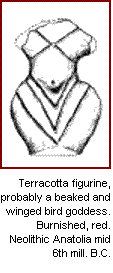| |
|
|
| |
|
|
There were long times in human her/story when women's life-enhancing, Earth loving cooperative values prevailed--when men were peaceful and revered the Mother. Artist Monica Sjoo, quoted in When new data no longer fits our existing worldview, the incongruencies inspire new questions. Pioneering thinkers follow their inner promptings, applying scholarship and synthesizing their findings until a new picture emerges--an expanded viewpoint that shifts the old paradigm. However, what begins with the desire for truth inevitably upsets and threatens the status quo. From
the Realm of the Ancestors (1997)--a collection of essays by scholars,
poets and artists--is a major tribute to the pioneering influence and
vision of archaeologist Marija Gimbutas (1921-1994). In her lifetime,
Gimbutas published twenty-eight books and over 300 articles on European
prehistory. Originally recognized as a Bronze Age scholar, her early
explorations of folklore in her native country of Lithuania eventually
led to twenty-five-years of multi-disclipinary research on the Neolithic
period in southeastern Europe (c. 6500-3500 BC). Her fresh interpretations
of the iconographic imagery unearthed through anthropomorphic and zoomorphic
figurines and pottery found in ancient settlements and gravesites, revealed
peaceful agrarian cultures that revered women and placed feminine values
at the center of spiritual life. Her interpretations have been met with
controversy, even dismissal, from more traditional colleagues, but with
gratitude and acclaim by those who welcome an alternative to the prevailing
androcentric worldview. Juxtaposing
the voices of traditional academics with cutting-edge scholars, these
essays present new-paradigm thinking and suggest the range of subject
matter GODDESS IMAGESOne
of the many themes discussed in this anthology concerns the interpretation
of female figurines that Gimbutas refers to as "goddesses." In part
three, poet Judy Grahn describes her initial reaction to some of the
female images unearthed from the Neolithic period: They seemed "odd,
. . . with big breasts and buttocks, covered with strange markings,
baffling female faces with beaks or huge eyes, bodies with strident
triangles at the pubic area. . . ." After further investigation, she
intuited that the ritual painting of women's bodies for blood ceremonies
(such as first menstruation) was part of their THE MYTH OF PROGRESS The feminist thealogian [note: thealogian is
not misspelled = study of the female deity, in contrast to the male
form theo-logian] Carol Christ points out that civilization was not
preceded by an inferior culture but by a worldview that reflected a
longstanding state of high social development. This non-hierarchical,
nature-attuned, peaceful and highly artistic culture was never completely
erased after the invasions of iconoclastic marauders. Rather, the older
culture provided a matrix for later beliefs and practices. Findings
from ancient sites along the continental periphery of southeast Europe--places
like Minoan Crete, Cypress and the Aegean archipelago--indicate the
veneration of a pre-Greek Goddess through an abundance of ceremonial
artifacts. We begin to see what fed the psyches of these ancient
people whose mystery cults link to the pre-Socratic philosophers (who
nearly always claimed no predecessors). In the words of Judy Grahn,
"Our sense of time has been utterly changed.... ‘Ancient' no longer
means from Greece, Rome or even Sumer; the arc of history is far longer,
and its longest strand is startlingly woman-centered."
By more closely examining the subsequent "myth of progress" in light of the earlier  nature-based culture, Carol Christ says we begin to "unmask the history
of violent conquest at the heart of what we call civilization." Yet,
in the words of Marija Gimbutas, "It is a gross misunderstanding to
imagine warfare as endemic to the human condition," as "humans were
once capable of living in harmony with each other, with nature and with
the sacred."
nature-based culture, Carol Christ says we begin to "unmask the history
of violent conquest at the heart of what we call civilization." Yet,
in the words of Marija Gimbutas, "It is a gross misunderstanding to
imagine warfare as endemic to the human condition," as "humans were
once capable of living in harmony with each other, with nature and with
the sacred." Art historian Susan Moulton describes the demise of this ancient worldview that  was forced underground. "The patriarchal systems that supplanted the
earlier matrifocal traditions attempted to eliminate all traces of prior
cultures that honored sacred powers of women. A New World Order was
established where there was no more room for a feminine dimension of
the divine."
was forced underground. "The patriarchal systems that supplanted the
earlier matrifocal traditions attempted to eliminate all traces of prior
cultures that honored sacred powers of women. A New World Order was
established where there was no more room for a feminine dimension of
the divine." Starhawk brings us full circle by reflecting on the man-made imbalance affecting the natural world. "If the sacred is immanent in nature, then we no longer have license to exploit, pollute and destroy the natural systems which sustain life. If the sacred is embodied, then our bodies carry with them a sacred authority. If the Earth herself is the location of the sacred, then we must learn to live in harmony with the Earth." In this worthy tribute to Marija Gimbutas, Joan Marler brings together a chorus of voices that stand for the ancient, sacred ties to the Earth and its inhabitants. Although the traces of prehistory have been effaced, scholars have pieced together a now established worldview of women as creators of culture. From the Realm of the Ancestors celebrates women as mirrors of nature and points to what human civilization can be--ecologically embedded, egalitarian and non-militaristic. The legacy of Marija Gimbutas continues to foster this vision by enlightening and inspiring those who can recognize its truth. PRIOR TO THE WRITTEN WORD
|